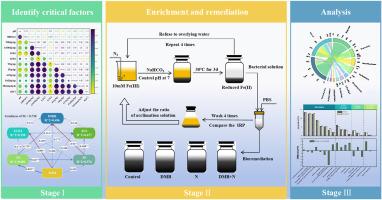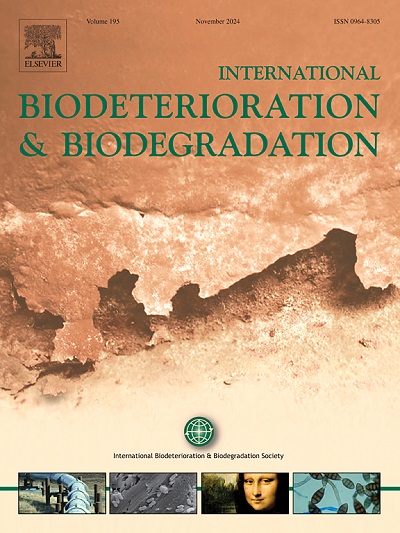A new enrichment strategy of dissimilatory iron-reducing bacteria for remediation of organic-contaminated river sediments: Process, performance, and mechanism
IF 4.1
2区 环境科学与生态学
Q2 BIOTECHNOLOGY & APPLIED MICROBIOLOGY
International Biodeterioration & Biodegradation
Pub Date : 2024-10-26
DOI:10.1016/j.ibiod.2024.105944
引用次数: 0
Abstract
Dissimilatory iron-reducing bacteria (DIRB) have been widely applied to organic matter metabolism in sediments due to their specific biological properties, which are significantly affected by environmental factors. Until now, there has been no systematic study on applying these effects of environmental factors to DIRB enrichment. In this study, we identified the critical environmental factors through RDA, PLS-PM, and correlation analysis and then adjusted the proportion of these factors (C/Fe, C/N, and Fe/S) through single-factor and response surface experiments to enrich DIRB. The performance of the enriched DIRB in carbon metabolism of organic-rich sediments was analyzed by remediation experiment, and the metabolic mechanism was revealed through iron-reducing performance, community structure, and functional genes. The results showed that the carbon, nitrogen, phosphorus, and sulfur were crucial factors influencing the activity of DIRB in river sediments, and the enriched mud-bacteria mixture containing a large amount of DIRB (referred to as “DMB”) obtained by domestication under C/Fe = 0.492 and C/N = 13.659 showed the highest iron reduction rate of 55.51% ± 2.53%. The DMB exhibited better-sustained removal of total organic matter (TOM), which was higher than the control (MB) by 8.81%. Moreover, we discovered that the enriched DIRB: (1) had a better reduction effect on different Fe(III) forms, especially in carbon-limited and iron-limited conditions. (2) increased in abundance and established a beneficial symbiotic relationship with hydrolytic acidifying bacteria. (3) showed an increased abundance of functional pathways associated with organismal systems and signal processing (such as ABC transporters and Translation). These findings revealed the reasons for the improved efficiency of organic matter metabolism.

用于修复受有机物污染的河流沉积物的新型异嗜性铁还原菌富集策略:过程、性能和机制
由于溶铁还原菌(DIRB)具有特殊的生物特性,且受环境因素的影响很大,因此被广泛应用于沉积物中有机物的新陈代谢。到目前为止,还没有系统的研究将这些环境因素的影响应用于 DIRB 的富集。在本研究中,我们通过 RDA、PLS-PM 和相关性分析确定了关键的环境因子,然后通过单因子和响应面实验调整这些因子(C/Fe、C/N 和 Fe/S)的比例来富集 DIRB。通过修复实验分析了富集DIRB在富有机沉积物碳代谢中的表现,并通过铁还原性能、群落结构和功能基因揭示了其代谢机制。结果表明,碳、氮、磷、硫是影响 DIRB 在河流沉积物中活性的关键因素,在 C/Fe = 0.492 和 C/N = 13.659 条件下驯化得到的含有大量 DIRB 的富集泥菌混合物(简称 "DMB")的铁还原率最高,为 55.51% ± 2.53%。DMB 对总有机物(TOM)的持续去除效果更好,比对照组(MB)高出 8.81%。此外,我们还发现富集的 DIRB:(1)对不同形式的铁(III)具有更好的还原效果,尤其是在碳限制和铁限制条件下。(2)丰度增加,并与水解酸化菌建立了有益的共生关系。(3)与机体系统和信号处理相关的功能途径(如 ABC 转运体和翻译)的丰度增加。这些发现揭示了有机物代谢效率提高的原因。
本文章由计算机程序翻译,如有差异,请以英文原文为准。
求助全文
约1分钟内获得全文
求助全文
来源期刊
CiteScore
9.60
自引率
10.40%
发文量
107
审稿时长
21 days
期刊介绍:
International Biodeterioration and Biodegradation publishes original research papers and reviews on the biological causes of deterioration or degradation.

 求助内容:
求助内容: 应助结果提醒方式:
应助结果提醒方式:


